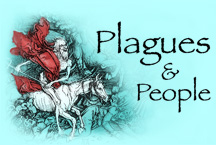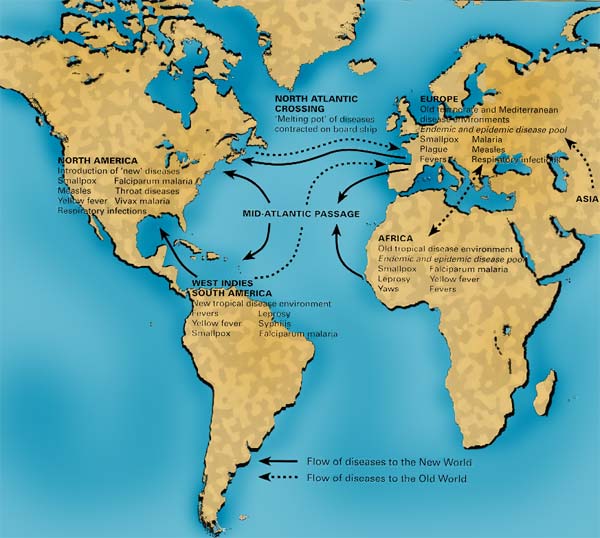HISTORY 135F

Infectious and
Epidemic Disease in History
Department of History
University of California, Irvine
Instructor: Dr. Barbara J. Becker
HISTORY 135F

Infectious and
Epidemic Disease in History
Department of History
University of California, Irvine
Instructor: Dr. Barbara J. Becker
The "Great Pox" |
Near the close of the 15th century, the population of Europe was hit by what seemed to be a fearsome new plague. The illness covered its victims with painful sores and left some horribly disfigured. It appeared suddenly following France's invasion of Italy in 1494. Afflicted French soldiers called it the "Neapolitan" disease. Italians, meanwhile, blamed the invaders and dubbed the affliction the "French" disease. Some modern epidemiologists have suggested that this supposedly "new" disease (known today as syphilis) may have existed in Europe prior to that time. Perhaps its presence escaped notice because its symptoms mimic those of diseases like leprosy, or because the numbers of individuals affected by it were too few and far between until living conditions set the stage for a wide-spread outbreak. Others have suggested the disease's sudden appearance was the consequence of a mutation in the microbe responsible for yaws, a related, but far less virulent disease. Yaws is a tropical disease unknown in Europe's harsher climate. Perhaps a genetic variation, one which facilitated the microbe's successful adaptation to the warm moist environment surrounding clothed humans' genitalia, enabled it to survive and thrive in these cooler conditions. The appearance of syphilis in Europe at this time is also coincident with the first intimate contact with New World natives whose immune systems had long since adapted to the disease. Explorers returning to the Old World may have unwittingly brought home the tiny spirochete, treponema pallidum, responsible for syphilis as an unwelcome microbial souvenir. |


Christopher Columbus and his crew are greeted by the natives of Hispaniola. |
In 1496, astrologer Joseph Grünpeck of Burckhausen (1473-1532) published a small treatise on "The Pustular Epidemic 'Scorre', or the French Sickness". After studying the celestial alignments conducive to the start of the disease, he concluded it had originated at the time of a conjunction of Jupiter and Saturn on 24 November 1484.
An illustration from Grünpeck's Treatise showing the alignment of the heavenly bodies at the moment of creation. |
by Francisco Lopez de Villalobos (1473-1557) As [Ferdinand and Isabella] dwelt in fair and stately show,... |
It has pleased Divine Justice to give and send us unknown afflictions, never seen or recognized or found in medical books, such as this serpentine disease. The which turned up and was observed in Spain in the year of Our Lord 1493 in the City of Barcelona, which city was infected and, in consequence, all Europe and the universe in all known and communicable regions. This disease had its origin and birth once and for all in the island now called Hispaniola [Haiti and the Domincan Republic], as has been determined by wide and infallible experience.
|
Jupiter from his solitary lofty throne on which he is accustomed to sit in state reviewed the fates and unraveled the future, greatly pitying the unlucky earth its troubles: wars, men's misfortunes, sturdy empires destined to fall, pillage, doors wide open to death, above all the new disease, a mysterious contagion, a disease not to be assuaged by any strength of human resource. The rest of the gods assented: Olympus shook and trembled, the aether was contaminated by a discharge from the new disease. Gradually the tracts of the air and wide space received the plague, and an unusual putrefaction came into the empty air and carried contagion over all the sky, either because, so many stars being in conjunction with the burning Sun, the fiery power attracted many vapors from the earth and sea, which, mingled with the thin air and gripped by this new corruption, then brought a contagion very rarely seen; or something else, sent down from the aether above, tainted the realms of the air far and wide....
|
The Virgin Mary offers a heavenly crown to Holy Roman Emperor Maximilian (1459-1519). Is the infant Jesus (like Apollo in the Tale of Syphilus) showering sinners with deadly arrows that afflict them with the dreaded Pox? Or, is he sending down benevolent healing rays to cure them? Or, perhaps, both?? |
 |
| Go to: |
|
|